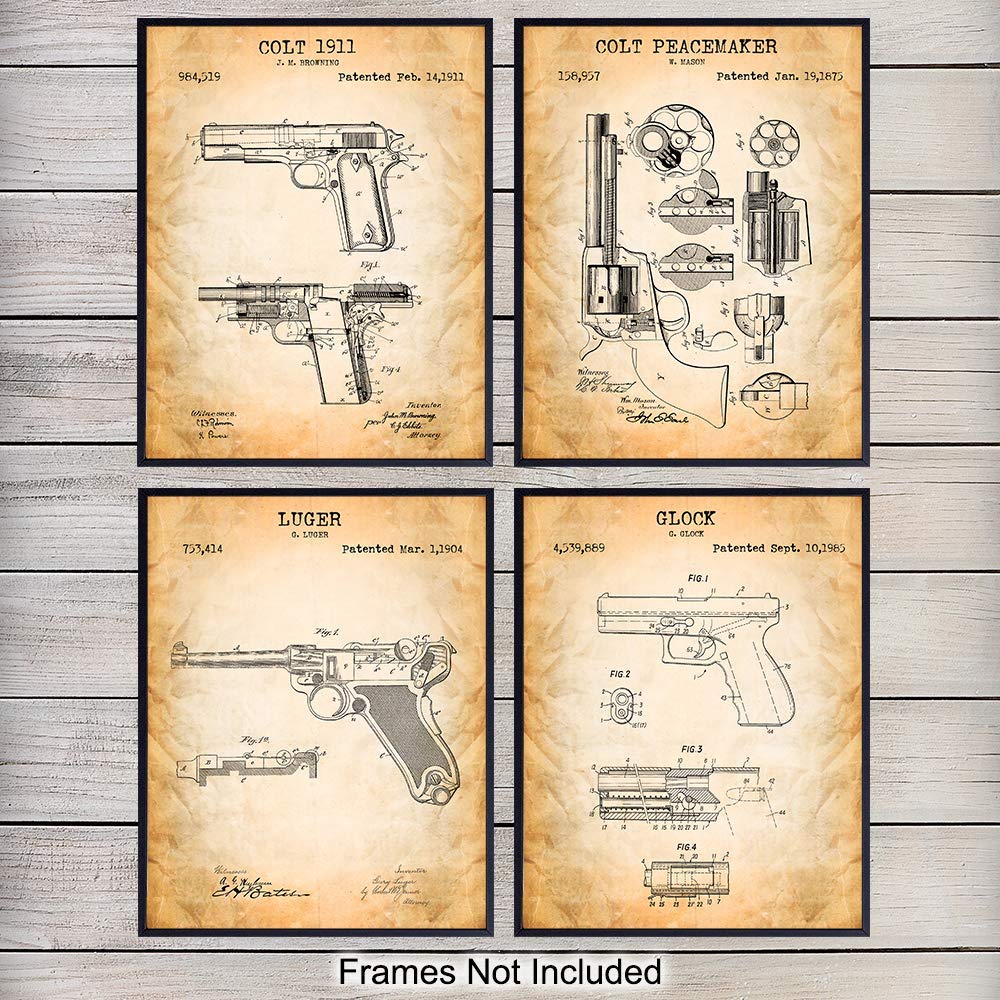Glock Patents - On April 30, 1981, Gaston Glock filed his 17th patent, which focused on a forward-looking pistol with many innovations. The gun at its core is today's Glock 17.
Although Mr. Glock currently holds more than 50 patents, some were filed as far back as 1953, when he was 51 when he filed the original patent for his G17 pistol in Austria. The polymer striker-fired pistol would first be adopted by its home country's military, and then in the consumer, law enforcement and military markets can only be described as a wild global success.
Glock Patents

The latest patent application, filed from an address in Vienna (Siebenbürgerstraße 16-12, A-1220), contained nearly 40 drawings and nearly a dozen separate claims.
Glock Pistol Patent Print Version #2
The patent application was several pages long and filled with numbers to define the new design features available on the market
The new pistol was largely designed and prototyped by Glock, who worked in his workshop in the small town of Deutsch-Wagram, north of Vienna, next to the garage of his home, where he founded his company in 1963. Before his pistol, the engineer patented and sold a rooting tool and field knife to the Austrian army, and also lent his talents to the design of grenade cases and machine gun belt connectors.
Mr. Glock built pistols for the Austrian military and law enforcement, which meant he had to be ready to fire at a moment's notice in life-threatening situations. To meet this critical need, Mr. Glock designed his pistol with three built-in safeties: trigger, latch, and drop safety to ensure the pistol's continuous operation while providing the best protection against accidental discharge. Mr. Glock also met additional Austrian government requirements with a high-capacity magazine, lightweight materials, a consistent trigger pull, and a hammer-forged barrel. Mr. Glock understood that reliability lies in simplicity, so he designed his pistol with as few parts as possible, minimizing its complexity. Today, the average GLOCK pistol has only 35 parts, significantly fewer than any other pistol on the market, making it more durable, reliable and easier to maintain.
On this side of the pond, the original G17 patent was accepted on September 10, 1985 and issued patent number 4,539,889.
Glock 17 1985 Patent' Poster By Daniel Seymour
In 1986, GLOCK opened its US headquarters in Smyrna, Georgia, where the so-called 1st generation G17s appeared in ads in national gun magazines in July with the slogan "Put the future in the palm of your hand."
Today, the G17 Gen 5 MOS is the last version of the pistol in production. The Marksman barrel comes with a barrel crown, nDLC coating on the barrel and slide, a two-handed slide, and the same 17 + 1 capacity as the original. Also, the profile is unmistakable from the original gun as shown in the 1981 patent drawings. A 1982 patent poster for the Glock pistol invented by Gaston Glock. The patent was issued by the United States Patent Office on September 10, 1985. The Glock pistol is a semi-automatic pistol with a polymer frame lock. Designed and manufactured by Glock of Austria. In 1982, he entered the Austrian military and police service.
Our proprietary prints allow you to have a piece of history in your home, office, Man Cave, Geek Den, or anywhere you want to add interest.

Prints are available in many colors and in all popular sizes. You can choose size and color when ordering. Larger sizes and additional prints are available. If you would like a larger size or a different print format or design, please contact me directly for pricing.
Police Wall Art Glock Pistol Patent Prints Police Wall
You will not find such a patent creation. I carefully select each patent based on its historical and artistic value. Often, several parts of a patent document are bound together in a single small print section. I carefully remove most errors and mistakes from the original document and perform extensive digital restoration while maintaining the integrity of the original patent. This results in a clean and clear printout, almost as it was the day it was submitted. I am not using a traditional printer and paper to print this artwork. Instead, I use a state-of-the-art lab and prints are made on professional photo printers using high-quality archival inks and acid-free archival Luster paper. Luster is a heavier paper with an excellent finish, vibrant colors and a fingerprint-free matte finish. This prevents the print from reflecting.
Prints are packaged to prevent damage during shipping. Prints are usually rolled flat (not rolled) and shipped in a rigid box with material to protect the finished print. Larger prints are delivered in a rigid mailing tube with material to protect the finished print. Please see store policies for more information on shipping.
Design patents, canadian patents, bold patents, patents help, patents law, patents for, legalzoom patents, file patents, get patents, cipo patents, genetic patents, dna patents
0 Comments